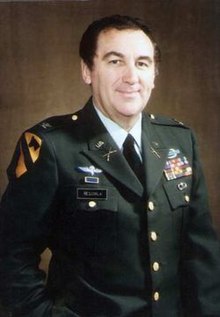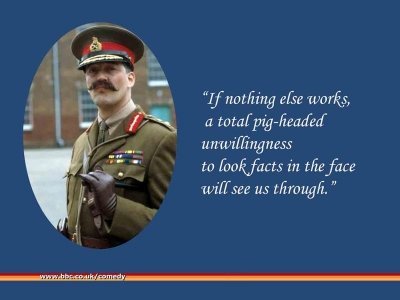WARNING: Contains images of appallingly bad head-dress and other uniform disasters. If anyone in your family is a warrant officer in the military, you may want to call an ambulance for the coronary they are definitely about to have after seeing some of these examples.
Dear readers. It seems that our little posts about Military Movie Clichés have been getting some attention. Our posts about grenades and rubbish officers have attracted a broad readership from around the world. Oddly enough we were getting a lot of individual hits from all the South American countries, which was a mystery until a friend mentioned they had been backpacking through the region and reading our blog as they went!
As a result of this, many people have been suggesting other things that we should write about, but things that don’t necessarily quite fit with the Movie Clichés theme. One of the topics that started a heated debate was the subject of crap berets in films (thank you Brillo and Cow Head). Why do you see actors walking around with berets that look like the unwanted lovechild of a hat and an aircraft carrier? Some look like Che Guevara has been taking fashion tips from a blind French mime artist. No soldier would be seen dead in the kind of milliner’s blancmange that Sly Stallone has sported over the years.
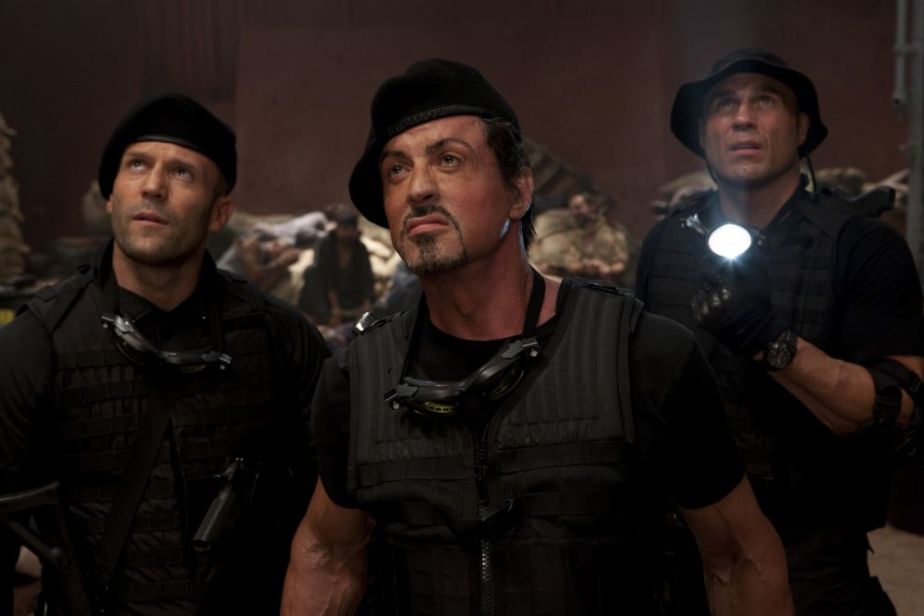
But how did a Pyrenees shepherd hat that looks like a pancake become the standard military uniform?
Military Origins: The beret has been around for many years, but it was the French Chasseurs Alpins (Alpine Hunters) that were the first military unit to adopt it back in the 1880s. They were created to protect their mountain borders after Italy got their act together and unified in the latter half of the 19th century, which included reforming their army and creating their own mountain regiments.

Their uniform was designed to be practical in the mountains, and they adopted the beret as it was worn by the locals and shepherds. One advantage was clearly the ability to shelter an entire platoon under one hat during inclement weather. This might have been the end of the military’s relationship with the beret, had it not been for a man called Hugh Elles.
The Men in Black
Sir Hugh Jamieson Elles, at the age of 36 was given command of a secretive military unit in the British Army called the Heavy Branch, which was part of the Machine Gun Corps (MGC). The MGC had been created a year early in late 1915 in order to meet the need for a better understanding and use of machine guns in The Great War. The Heavy Branch followed less than 6 months later with the sole purpose of manning the very first tanks ever to be used in combat. Once the secret was out and the existence of tanks was known by the Germans, the Heavy Branch split away from the MGC and became the Tank Corps, now the Royal Tank Regiment (more on those splendid chaps later).
Life in a tank during WW1 was unpleasant, and it quickly became apparent that most of the uniform designed for regular troops was unsuitable for tank crewmen, in particular the peaked caps. The peak prevented the soldier being able to get his eyes close enough to the sights or viewing slits, and the shape of the cap made it difficult to wear radio headsets when they were introduced. As the war was drawing to a close, Elles and Colonel Fuller were discussing the future of the Tank Corps, including uniform, when Elles spotted the aforementioned Chasseurs who were camped nearby. According to legend, he tried one on and history was given a sartorial upgrade. He thought, however, that the Chasseur beret was “too sloppy” so a compromise based on the Scottish tam o’shanter was designed. The ToS had been used by some Scottish regiments throughout WW1. In 1923 the Tank Corps became the Royal Tank Corps under King George V, and in 1924 he officially granted the sole use of the beret to the RTC (something they had been doing unofficially for years). It wasn’t until 1940, that the rest of the British army’s armoured regiments begrudgingly followed suit.
Special Forces and MURICA!
Slowly but surely, other specialised regiments began to see the value of the beret. It could be rolled up and stuffed in a pocket for starters. The newly formed Parachute Regiment started using the maroon beret (the colour apparently chosen by the author Daphne de Maurier, who was the wife of a high ranking general at the time), with the Commandos and Marines adopting the green beret shortly after. The rest of the British military followed suit in the years following the war. American paratroopers were given berets by their British counterparts, many of whom went on to be part of the US Special Forces Group in the post war years. Despite being told not to, they wore the beret throughout the 50’s until the famous ‘Green Beret’ was officially sanctioned in 1961. Other units were allowed to do the same in the 70’s as part of a drive to improve morale. In 2001 the US Army ordered that the black beret would be worn as standard, however a decade later they reverted back to the cloth cap after complaints were made by soldiers that the beret was ‘too hot’.
So that’s the history behind the military beret, but who wears it well, and who is danger of being carried off in high winds?
‘Street Fighter’ – 1994
This film only popped into my head yesterday as it was on television on one of the high numbered channels that is normally reserved for foreign news networks and depressingly low grade pornography. Apparently over half of the budget went on hiring Jean-Claude Van Damme and the terminally ill Raúl Juliá (a brilliant actor who is thankfully better remembered by most as the Gomez in the Addams Family) who received a state funeral in his native Puerto Rico when he died 2 months before the film was released.
Because of the budgetary constraints, the rest of the roles went to unknown actors and actresses, including a diminutive Australian actress called Kylie Minogue. Whilst she has some undeniable talents which could lead you to forgive this monstrosity….
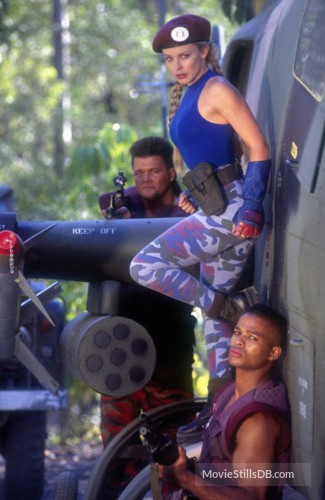
… but this blue cowpat is a disgrace to berets everywhere. Even the Chasseurs would giggle if they saw it.

But Kylie isn’t the only fashion casualty of this particular costume department war. JCVD can’t even decide which side to wear his on.


Before anyone can claim the picture has been reversed, look at the scar on his eyebrow. So maybe ‘Street Fighter’ isn’t the best movie to be measuring with the military-accuracy-yard-stick. We would be here all year! After all, it does have a green dude who is not only electric, but looks as though he’s gone eight rounds with Eubank Jnr (#topicalsportsreference).

‘Starship Troopers’ – 1997
Treading a fine line between clever satire and dumb celebration of fascism, ‘Starship Troopers’ started life as a script with the terrific B-movie title of ‘Bug Hunt at Outpost Nine’. During pre-production it was noted that the plot of the script was rather too close to the novel ‘Starship Troopers’ for comfort. Rights to the novel were hastily bought, the title changed and character names adopted to match. Director Paul Verhoeven attempted to read the novel, but abandoned it after two chapters claiming it was boring and depressing.
Despite having the leading military consultant Dale Dye on board as the military advisor, there are some cracking examples of crap hats. The picture below shows a variety of what’s on offer, ranging from the ‘Ok, but a bit big’ to ‘Hey dude in the second row, your hat is causing a localised eclipse’.
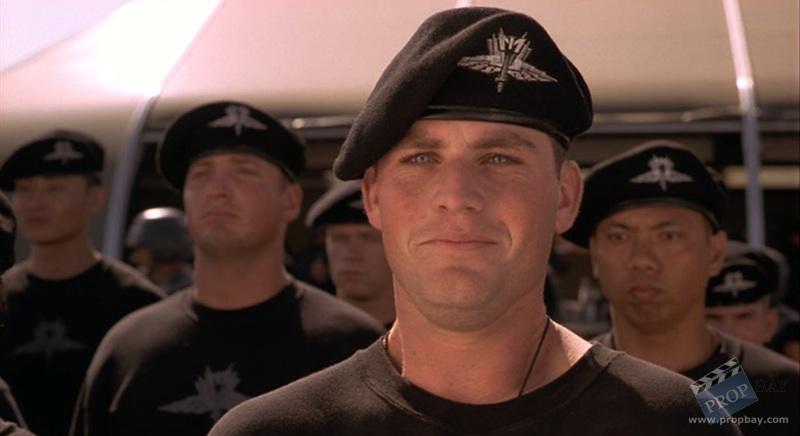

‘Private Valentine: Blonde and Dangerous’ – 2008
What do you mean you’ve never heard of this blatant rip-off of ‘Private Benjamin’ ?! Don’t worry neither had I, and for good reason. It was only ever released in Russia and Bulgaria (those two titans of eastern block cinema) and subsequently on DVD in the USA under the title ‘Major Movie Star’. No English speaking country would touch it with a barge pole. If it hadn’t bankrupted everyone involved in this cinematic travesty, then I would suggest Ben Elton and Richard Curtis should sue for robbing the title of one of the best Blackadder episodes (the one where Baldrick plays a slug balancer…).
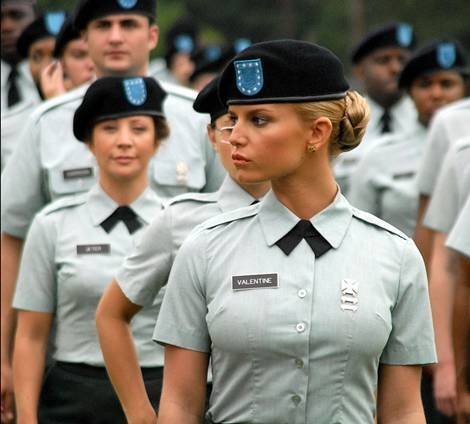
I only include it in this list for three reasons. Firstly as a public warning, secondly so that Jessica Simpson’s shirt can finally be awarded the Oscar for best supporting actor that it justly deserves (how no one was killed by flying buttons is a credit to the costume department) and lastly because of the beret warn by the woman two rows back in this picture. It looks like a laundry bag has been upended on her top of her, and the biggest, blackest (steady now) baggiest pair of pants has landed on her head…then miraculously sprouted a cap-badge. She was probably temporarily deaf in her right ear during the filming of this scene.
Conan O’Brien made a public plea on his show for the film to get a public release, saying the “bad defines the good” and the apparent “85 minute stinkbomb” of ‘Major Movie Star’ would only help to highlight how good ‘Schindler’s List’ really was.
‘Private Benjamin’ – 1980
Maybe Jessica Simpson copied everything from Goldie Hawn, including her propensity for shocking head adornments. Suddenly I’m getting nostalgic for ‘Street Fighter’

‘The Wild Geese’ – 1978
Disrespectful, ill-disciplined and with some of the greasiest poops known to man, real life geese are nothing like this ensemble cast of veteran actors. That being said, 50% of Richard Harris’ fee was held as ransom to ensure he behaved on set, as he was known for delaying shoots by being drunk, ‘misbehaving’ and rewriting his lines, and Richard Burton was attempting to be teetotal at the time. ‘Wild Geese’ has not stood the test of time particularly well. It was considered racist, even at the time when filming in apartheid South Africa.


The military advisor was a South African mercenary, which may explain the dodgy headgear that everyone is sporting.
Any Steven Seagal Movie Where he Wears a Hat


No explanation required for this. I think I prefer the chef’s ‘toque’. At least it has some bloody shape to it.
‘The A-Team’ – 2010
Whilst ‘The A-Team’ movie was enjoyable in parts, it had a nonsensical plot that was only marginally more believable than Quinton “Rampage” Jackson’s acting. Luckily you only see the team in their berets as they are present at their court-martial, but they look like a tray of yorkshire puddings.

They are also remarkably ill-fitting, but that’s probably because NONE OF THEM HAVE HAD A SODDING HAIRCUT. The proposed sequel was cancelled, probably purely on the berets alone, but also because it didn’t perform as well at the box office as expected.
‘Stargate’ – 1994
Kurt Russell has been clearly getting fashion tips from his wife Goldie Hawn. I’m a big fan of the ‘Stargate’ film (not as much as a friend of mine that has the earth coordinates tattooed on his torso), but Kurt Russell’s bonnet is going to give him some funny tan lines. Why is he the only military guy wearing one when everyone else in sensible helmets. Also why black?! It’s the desert.

‘A Bridge Too Far’ – 1977
One of the best, and most accurate war films of all time, with an incredible cast. There are so many big names in this film, it’s like a game of famous actor bingo, and it was one of the very first military movies that had the actors put through a military boot camp in preparation, at the insistence of Richard Attenborough who was in the director’s seat. So why bring it up here?
Two reasons, firstly Gene Hackman who plays Polish general Sosabowski. Not only is his accent module stuck somewhere on shop demonstration model, varying wildly between Cornish and phonetic Transylvanian, but his beret is ridiculous.

But hold on! Whilst his accent is inexcusable, the beret is in fact highly accurate. Take a look at this picture of the real General Stanislaw Sosabowski.
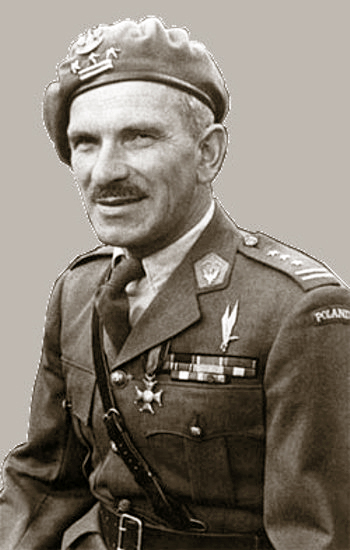
It appears that when you are a general, you can wear your hat any way you goddam please!
The second reason is slightly tenuous, but important nonetheless. In the film when the besieged British paratroopers are desperate for supplies, a canister is dropped in the open in a nearby field. A soldier decides to make a brave run for it, cheered on by everyone else, but is gunned down by German machine gun fire as he is attempting to make his way back. The canister falls to the ground and splits open to reveal a stash of maroon berets and nothing else. Remarkably this is a true story, but you will be relieved to hear that the man, Cpl ‘Johnny’ Johnson survived. The berets in this article are bad, but none of them have got someone killed!
The Real McCoy
So what should a beret actually look like? Well it depends vastly depending on the country of origin, but in some cases the military unit you are part of. British military guidelines state that the beret…
“…shall be worn evenly on the head, with the sweatband 2.5 cm above the eyebrows, the badge centred over the left eye, and the crown pulled downward to the right. The break of the sweatband shall be worn centred at the back of the head, with no drawstrings visible.”

No two berets will look exactly alike, and there will always be local variation in style, but if you are losing sight in your right eye, or hearing in your left ear then you are probably doing it wrong. It should fit snugly on the head without a space big enough to hide bakery products underneath, although the much larger american cap-badges tend to result in a large fold of material behind it.

Other nations go for a ‘bigger is better’ approach. This soldier from the Jammu and Kashmir Police looks particularly badass, even if his beret is laughable by British standards…

…whereas this Indian general clearly grew the moustache to take your eyes off his beret.

But the British have little to complain about. This is how our future king dresses. No wonder they made him switch to the RAF!

So it seems that the higher rank you are, the more outrageous you can be with your beret. Just look at Field Marshall Montgomery.

I give up! With examples like this to follow, you can see how the movies get it so wrong. I’m going go watch ‘Private Valentine’ and then go for a lie down.
What else about military movies really gets your goat. Let us know.
Bare Arms was set up in 2013 to provide assistance to film and television productions. They provide advisers to military themed productions, as well as kit and equipment. Occasionally they write rubbish blogs too!
















